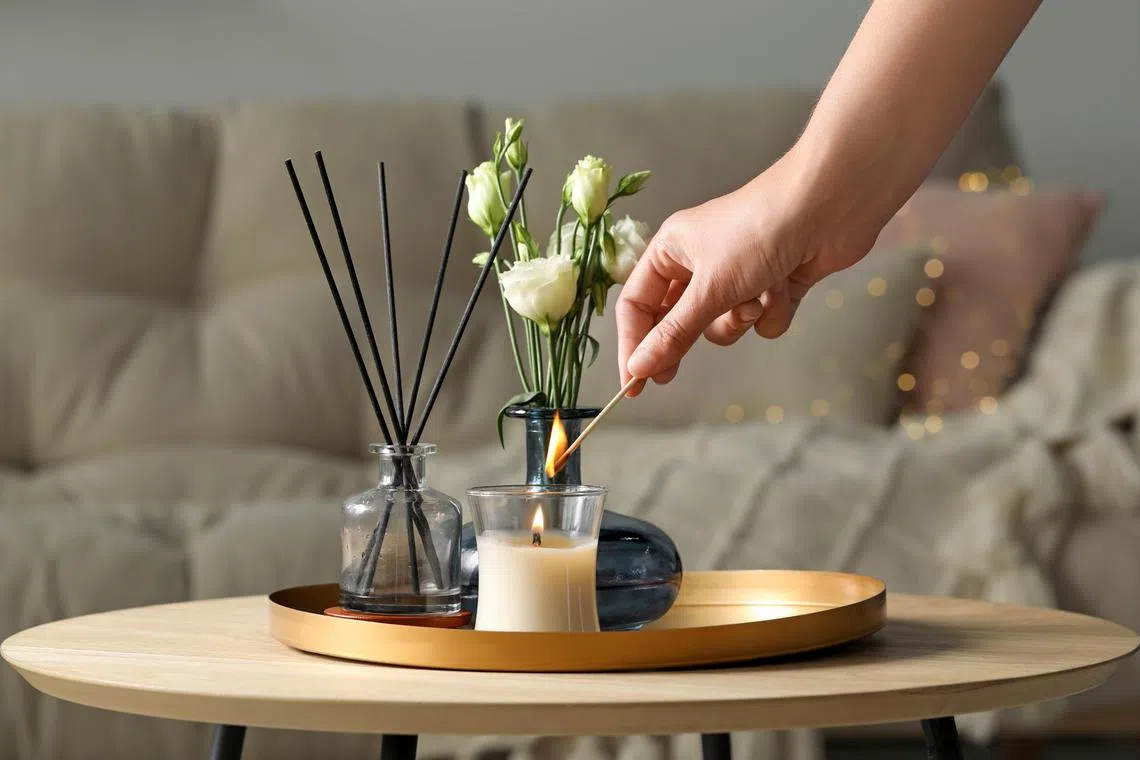Scents of place: How fragrances liven up spaces, from MRT stations to homes
Sign up now: Get ST's newsletters delivered to your inbox

While fragrances are popular in homes and hotels, more public spaces are using them to enhance the visitor experience.
PHOTO: ISTOCKPHOTO
Follow topic:
SINGAPORE – For a few weeks in November and December, Christmas was in the air at the Downtown Line platform of Newton MRT station.
Not just because it was the festive season, but also because the station was part of a scenting trial run by SBS Transit in partnership with local company Lynk Fragrances.
Stevens, Little India, Downtown, Telok Ayer and Bencoolen stations were also a part of this trial.
SBS Transit spokesperson Grace Wu tells The Straits Times that the collaboration “aimed to create an inviting atmosphere to liven the festive spirit of our passengers during the holiday season”.
Diffusers were used to release a light mist of the scent, which included notes such as fir and eucalyptus.
Standees at the platform explained the initiative and invited passengers to leave their feedback via a QR code. The response was overwhelmingly positive, says Mrs Wu, and SBS Transit is now in discussions with Lynk to explore opportunities to bring back scented MRT stations.
While luxury malls and hotels often design signature scents, a scented MRT station is novel. Other public spaces in Singapore, from the airport to a church, are also using scents to enhance the visitor experience.
Changi Airport’s terminals, for instance, are filled with the fragrance of orchid, damask rose, ylang-ylang, geranium, mint, citrus and South American yerba mate. Its Orchid Tea blend is intended to evoke Singapore’s ideal as “A City In A Garden”. This vision is echoed throughout the airport, which is filled with gardens.
The scent was introduced in 2016 and is dispensed at high-traffic touchpoints such as the airport’s departure hall doors.
The logistics of air travel are often seen as miserable, but the scent “aims to evoke pleasant sensory surprises for passengers and visitors as they navigate the airport”, a Changi Airport spokesperson tells ST.
Meanwhile, the Timezone arcades in Singapore – including its 22,000 sq ft outlet in Orchard Xchange – are infused with an aroma of watermelon, passion fruit and apricot.
These beloved family-friendly spaces are a hallmark of childhood in Singapore. It is easy to imagine that if they smell of anything, it is likely a queasy mix of adolescent sweat and other body odours.
But the sweet smell of Timezone was crafted for the entertainment chain and introduced in 2018, says Ms Jacquline Ong, head of marketing at Timezone Singapore.
“The goal was to create a scent that evokes positive memories and emotions, and which connects guests to the joy and excitement of being at a Timezone venue,” she says.
“Many of our guests have shared that they can smell Timezone even before seeing our venues, especially at Orchard, where the scent greets visitors as far as the train station, adding a unique and memorable layer to their experience,” she adds.
Indeed, scents are a subtle and powerful way to evoke emotions, moods and memories.
This happens because scents are processed in the brain’s olfactory bulb, which sends the information directly to the hippocampus and the amygdala – two parts of the brain which make memories and process emotions.
So, different natural scents can trigger different emotions in people, says Ms Elizabeth Ho, founder of scenting consultancy service La Brise de Parfum.
“For example, the peel of a lemon has a potent scent which is stimulating and thought to help with focus,” she says.
The scent of lavender, on the other hand, is thought to encourage relaxation.

Scents are a subtle and powerful way to evoke emotion, moods and even memories within a person.
PHOTO: ISTOCKPHOTO
Organisations consult Ms Ho to find scent blends that work for their business. Her portfolio includes luxury hotels, dental clinics and even the Church of St Alphonsus, or Novena Church, in Thomson Road.
For Ms Ho, a devout Catholic, the church project was a dream come true.
“It was an opportunity to craft a scent that would be appropriate and conducive to such a spiritual setting,” she says.
The main request from the church was for the scent to be natural and to kill germs. “But I felt that it should also evoke feelings of calm and meditativeness,” she says.
She designed a blend, Aroma di Novena – composed of frankincense, lavender, citrus and rosemary – which is still used in the church today. It was introduced in 2017.
“Frankincense was one of the gifts for Jesus when he was born, so it has a very spiritual connotation. Lavender is calming, while citrus encourages focus,” explains Ms Ho.
Parishioners can bring the scent of the church home, as the Aroma di Novena essential oil blend is sold in the church’s shop.
The scent is diffused throughout the church via the central ventilation system, which is the typical method used within buildings and large spaces to deliver a scent.

The signature scent of Novena Church includes frankincense and lavender among other ingredients.
PHOTO: ST FILE
Another consideration for scenting a large space such as a church – or an MRT station – is ensuring that it has broad appeal and is not likely to trigger allergies or sensitivities.
One way of doing this is by using natural ingredients, or a blend of natural and synthetic oils.
“We were mindful of passengers who may have sensory sensitivities, which is why we partnered Lynk, as its fragrances are made from natural ingredients,” says Mrs Wu of SBS Transit’s aromatic MRT station initiative.
In contrast, there are many more options when scenting a residential home or personal space – there is less square footage to plan for and far fewer people that the scent must please.
Scented candles or incense sticks have long been the go-to for home scenting, but the technology for delivering scents within a space has expanded past these options.
“I’m not the biggest fan of candles or incense,” says Ms Ho. “I find they can be messier, and the burning smell can disrupt the scents as well.”
Instead, she recommends ultrasonic or nebulising diffusers, which are often colloquially referred to as water-based diffusers or mist diffusers, respectively.
Ultrasonic diffusers use ultrasonic vibrations to disperse a mixture of water and essential oils as a fine mist. On the other hand, nebulising diffusers use pressurised air to break essential oils into fine particles and release them as a concentrated mist. These diffusers require no water or heat, and offer undiluted diffusion of scents.
“Ultrasonic diffusers are quiet and can double as humidifiers, while nebulising diffusers are portable. I often take one with me during my overseas travels,” she says.
She sells a remote-operated aroma diffuser that comes with colour modes and automatic shut-off.
Mr Lincoln Thong of Pristine Aroma, a local company which sells pre-made scent blends, suggests that room sprays can also be useful in specific scenarios.
For instance, they can be used to freshen up a bathroom, or be spritzed on linens or curtains in a bedroom.
Pristine Aroma’s best-selling product is its Himalayan Tea blend, which customers liken to the scent of Ion Orchard mall. Pristine’s blend is made with synthetic and natural ingredients.
“We are not an official supplier to the mall, but our customers noticed the similarity,” says Mr Thong.
The Himalayan Tea fragrance can be purchased for use in a reed diffuser, mist diffuser, spray or even a sand candle – a new product inspired by social media that the company launched in December 2024.
Sand candles are made of granulated wax, which has a sand-like texture. The sand can be poured into any container, even one containing water or decorative stones. After burning, users dispose of the spent wick and any melted sand wax. The leftover wax can be stored or used in another container for the next burn.
Lynk Fragrances, which partnered SBS Transit for the scented MRT station trial, also sells a range of scent blends in a variety of delivery methods, including shower steamers and poo sprays. These include the Frosted Fir scent that was used in selected Downtown Line stations over the festive season.
The company also sells single essential oils, such as ylang-ylang and sweet orange, so scent lovers can customise their own blends.
They might use, for example, lemon for the study or home office, lavender or peppermint for the bedroom, and tea tree for the bathroom.
Scientific literature about the effects of different ingredients is mixed. Nevertheless, studies have shown that aromatherapy has potential as a stress-relief tool, especially when incorporated into a regimen of healthy habits such as physical activity.
So, when considering what essential oils to use in a custom blend, take any claims of medicinal or healing effects with a grain of salt.
To make a simple blend, Ms Ho recommends a 30/50/20 ratio of top, middle and base notes, respectively. For instance, try three drops of top notes such as lemon or eucalyptus, five drops of middle notes such as rosemary or lavender, and two drops of base notes such as cedarwood.
You can add this blend to a reed diffuser base solution – available for purchase on e-commerce platforms such as Shopee – or directly into a mist diffuser.
Alternatively, make a DIY essential oil spray by mixing 10 drops of the scent blend with two tablespoons of rubbing alcohol and half a cup of distilled water.
A wider range of single essential oils and blends can be found at home-grown brand Hysses or e-commerce retailers such as iHerb.

